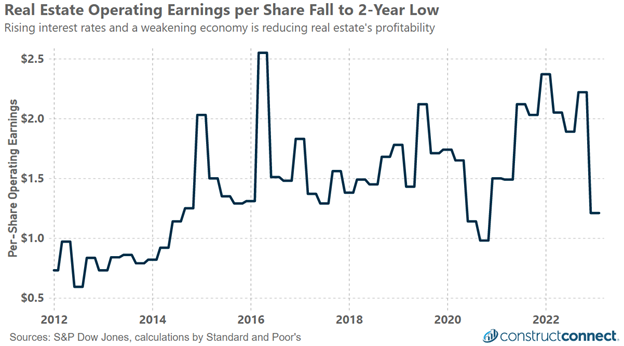Among the real estate firms listed on the Standard and Poor’s 500 Index, earnings per share in Q4 2022 stood at $1.21, reflecting a significant decline of 46% and 49% compared to the levels recorded one quarter and one year ago, respectively. Certainly, 2022’s rising interest rate environment was a significant headwind as the sector is highly dependent on floating interest rates which during the past year rose at their fast rate in history.
Based on Q4 2022 performance, the real estate sector ranked at the bottom among the eleven sectors in the S&P 500. Out of the thirty firms within the sector, 66% exceeded their Q4 estimates, while 33% fell short. In contrast, among all 500 firms in the Index, 77% surpassed their estimates and only 20% fell short.

Forward-looking expectations for the sector include a partial recovery in Q1 2023 that unwinds nearly half of the recent fourth-quarter decline, according to data provided by Standard and Poor’s. However, the pace of recovery in operating earnings thereafter and continuing through year-end 2024 is underwhelming.
Assuming the sector meets its Q4 2024 operating earnings expectations of $1.90 per share, the sector’s earnings will be 15% below its Q3 2022 performance of $2.22 per share. Any inflation that occurs over this time will further erode these already lackluster results.
Many news outlets have emphasized the anticipation of a short and mild recession in 2023 for the United States. However, it is important to note that these expectations pertain to the country as a whole and do not specifically address the construction industry. Should Wall Street’s sector outlook prove accurate, construction business leaders should prepare for a prolonged downturn in the sector rather than a minor recession.
This will require the prioritization and near-term implementation of internal cost management and operational efficiency measures. Among externally focused efforts, many of them learned and perfected during the Great Recession, should include revenue diversification and targeting multiple verticals in order to both maintain sufficient work to cover fixed costs and secondly to retain critical workers through the downturn. This proactive approach will enable firms to navigate the challenges ahead and position themselves for optimized growth when the industry more broadly rebounds.
